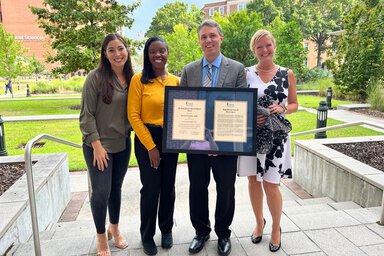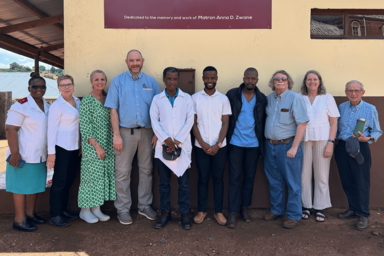Technology Applications Center for Healthful Lifestyles (TACHL)
About TACHL
Welcome to the TACHL, a distinguished South Carolina Health Sciences Center of Economic Excellence. Established in 2010 within the College of Nursing at MUSC, TACHL is dedicated to advancing population health through the strategic use of technology.
At TACHL, our primary goal is to enhance access and elevate the quality of evidence-based care. To achieve this, we focus on the development, testing, and dissemination of digital innovations that promote health, prevent disease, and effectively manage health care. Our initiatives are designed to address and minimize disparities in both health outcomes and health care provision.
Collaboration lies at the heart of our success. We boast a rich history of partnerships with technology teams in the Charleston tri-county area, fostering innovation across campus and in the broader Carolinas region. Join us on the forefront of technological advancements that contribute to a healthier future for all.
TACHL Projects
Bounce Back Now
Bounce Back Now is a smartphone app that is designed to improve access to evidence-based mental health care among victims of natural and technological disasters. Only 1 in 4 individuals who develop mental health problems after disasters receive mental health services. The Bounce Back Now app provides coping tools, brief interventions, symptom tracking resources, and connection to helping professionals. Visit Bounce Back Now for more information.
Center for Firefighter Behavioral Health
The Center for Firefighter Behavioral Health (CFFBH) houses a series of web- and smartphone-based tools designed to address the behavioral health needs of firefighters and their families. These resources are freely available to firefighters, their families, and the behavioral health providers who serve them. Visit Center For Firefighter Behavioral Health for more information.
Supporting Providers and Reaching Kids
The Supporting Providers and Reaching Kids (SPARK) initiative aims to make it easier for mental health providers to deliver best practice treatment to children. SPARK is a web-based platform that houses a collection of games and activities that providers use in session to teach children and their caregivers core concepts and skills that are common elements of cognitive behavioral treatments. Visit Supporting Providers and Reaching Kids for more information.
Trauma Resilience and Recovery Program
The Trauma Resilience and Recovery Program (TRRP) is a stepped care intervention for patients who have experienced traumatic injury (e.g., serious motor vehicle crashes, motorcycle crashes, gunshot wounds, stabbings, serious falls). More than 20% of these patients develop posttraumatic stress disorder or depression. Visit Trauma Resilience & Recovery Program for more information.
TRRP Partnership between GW & MUSC
The Resilience and Recovery Program Study at George Washington Hospital focuses on patients’ emotional and behavioral recovery after they have experienced a traumatic injury. More than 20 percent of injury patients may experience depression or anxiety in the first year after injury. Learn more about the partnership.
TACHL News
TACHL Success Stories
Dr. Leigh Ridings
Dr. Leigh Ridings is a licensed clinical psychologist at MUSC. She worked with TACHL, via the Trauma Resilience and Recovery Program, to provide mental health care to young children after traumatic injury. This resulted in novel ideas to adapt the TRRP model and develop a new, integrated model of care.
Dr. Ridings was awarded a pilot grant from the South Carolina Telehealth Alliance to develop her “CAARE” concept via interviews with caregivers of young children after injury, and also was awarded a TACHL pilot grant to survey 75 pediatric trauma centers. Most recently, she received a K23 career development award from the National Institute of Child Health and Human Development.
Dr. Aaron Lesher
Dr. Aaron Lesher is a pediatric burn surgeon at MUSC. Dr. Lesher worked with TACHL as he led the development and pilot testing of a novel telemedicine optimized burn intervention (TOBI) for pediatric burn-injured patients and their caregivers. He was awarded a $200,000 Blue Cross Blue Shield of South Carolina Foundation grant to build the initial app, and then was awarded a K23 career development grant from the National Institute of Child Health and Human Development (NICHD). Dr. Ken Ruggiero serves as his primary mentor on the K23 award, which launched in 2020. The award will give Dr. Lesher more time to pursue his innovative model of care that may change the paradigm of how clinicians treat burn patients.
Dr. John McGillicuddy
Dr. John McGillicuddy worked with TACHL & CON mentorship team, and received a SCTR KL2, 3-year development award. With guidance from TACHL leadership, Dr. McGillicuddy created and tested an mHealth medication regimen adherence program with 20 kidney transplant recipients. From that project, he gathered analyzed and incorporated acceptability and usability data into an NIH R01 application, which was scored and funded upon initial submission. Dr. McGillicuddy recently completed recruitment and is in process of follow up and data analysis for a competing renewal submission in Spring of 2020. He will continue his work in partnership with TACHL mentorship team.
Dr. Shannon Phillips
Dr. Shannon Phillips worked with TACHL, CON mentorship team, and an MD partner on a SCTR KL2, 3-year development award. She adapted and refined an existing app to meet the needs of child-parent dyads (children with sickle cell disease). She gathered, analyzed and incorporated acceptability and usability data into an NIH K23 application, which was recently funded. Dr. Phillips will continue her work in partnership with TACHL mentorship team as she runs her grant.
Dr. Ennis James
Dr. Ennis James worked with TACHL & CON mentorship team in conceptualizing an intervention to address fatigue experienced by patients with sarcoidosis. The TACHL mentorship team guided Dr. James through preparation of an initial R21 submission. The first submission received a 28th percentile score. TACHL mentorship then guided Dr. James through the grant proposal revision process including addressing reviewer comments, collecting additional data, and strengthening his C.V. through presentations and publications in preparation for a resubmission. Dr. James received an 8th percentile upon and received funding in September 2020. Dr. James and TACHL mentorship team will continue their partnership throughout the R21 and in preparation of an R01.
TACHL Leadership
Ken Ruggiero, Ph.D.
Dr. Ruggiero’s work centers on improving access and quality of mental health care, particularly to children and adults who have been affected by traumatic events such as disasters, serious injury, child abuse, and occupational incidents. This includes research on self-help apps for disaster victims (bouncebacknow.org) in collaboration with the American Red Cross, technology-enhanced treatments for survivors of traumatic injury (trrphealth.org), and resources for firefighters who experience critical incidents (cffbh.org).
He also leads an initiative (sparktoolkit.org) to improve quality of behavioral health care in partnership with over 30 youth-serving community mental health centers in the Carolinas and Florida. These initiatives have resulted in over 200 scholarly publications and have been supported by the National Institutes of Health, Department of Homeland Security, Veterans Administration, and MUSC Center for Telehealth.




